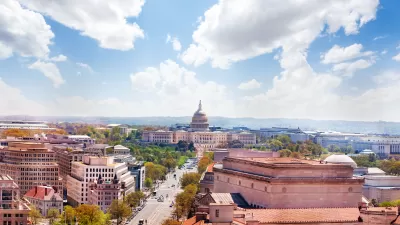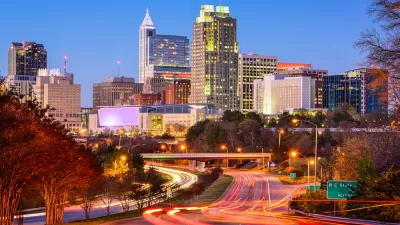Do skyscrapers cause 9-to-5 business districts?
In the ongoing debate over height limits (especially in Washington, D.C., where even a 20-story office building is too tall to be allowed) one of the many sub-arguments is over whether height limits are good or bad for downtown.
Supporters of height limits argue that if tall buildings are allowed, commercial activity will be concentrated in a small "skyscraper zone" and low-height blocks will become dead zones. By contrast, they claim that if buildings are limited to 10 or 15 stories, businesses will keep looking for downtown office space, and the mid-rise downtown will keep expanding as businesses priced out of one downtown district move a few blocks away. Height limit supporters note that Washington's low-rise downtown is fairly prosperous, while some Sun Belt cities have taller buildings and dead downtowns.
By contrast, skyscraper supporters argue that a business that cannot get what it wants in a tall downtown building is just as likely to move to suburbia as to move a few blocks away. They point out that Washington's low-rise downtown is by no means the only prosperous downtown in the United States, and that Washington has until recently been far less successful in competing with its suburbs than some high-rise cities. For example, New York has been gaining population since the 1980s, while Washington steadily lost population until the 2000s.
In an ideal world, one could run a controlled experiment between Washington with height limits and Washington without height limits. Obviously, this is not possible.
However, one can examine the cities with the tallest buildings in the United States. Do they tend to have healthy downtowns or weak downtowns? I begin by proposing a measure of downtown health: how many people walk to work? In 10 of the nation's 50 largest cities, over 5 percent of city residents walk to work (Boston, Washington, San Francisco, New York, Philadelphia, Honolulu, Seattle, Minneapolis, Chicago and Baltimore). This group includes cities with lots of tall buildings (New York, Chicago), low-rise Washington, and numerous cities in between those extremes.
Of the 50 tallest buildings in the United States, 29 are in either New York or Chicago. 8 more are scattered with cities with strong downtowns (four in Philadelphia, one each in Minneapolis, Boston, San Francisco, and Seattle). 13 are in cities with not-so-strong downtowns (3 in Atlanta, one or two each in Dallas, Houston, Los Angeles, Charlotte, Oklahoma City, Pittsburgh, and Indianapolis). So it appears that there is a modest but positive correlation between a vibrant downtown and tall buildings.
To be fair, my strong-downtown cities tend to be bigger than the weak-downtown cities; thus, it could be argued that their larger number of skyscrapers reflects their larger size. But if you compare the number of skyscrapers with the amount of office space, some of the strong-downtown cities still have more skyscrapers. In particular, Chicago has about one skyscraper per 15 million feet of office space (15 buildings in the top 50, 235 million feet of office space)* New York has one per 30 million (14 buildings, almost 430 million SF). Philadelphia has one per 34 million (4 buildings, 137 million SF).
Of the weak-downtown cities with more than one "top 50 building", only Atlanta comes close to Philadelphia (with 3 buildings and 140 million SF, for a ratio of one skyscraper per 46 million SF). Los Angeles has two skyscrapers and over 180 million SF, for a ratio of one per 90 million SF. Dallas and Houston have a similarly low skyscraper/office space ratio. On the other hand, so do walkable Boston and San Francisco. To put it another way: cities with lots of skyscrapers tend to have strong downtowns, but not all cities with strong downtowns have lots of skyscrapers.
Thus, skyscrapers are not absolutely necessary for a downtown with lots of people walking to work. But given that the most height-oriented downtowns are pretty healthy, it at least seems clear that tall buildings do not prevent such a result.
*Office space statistics are here.

Trump Administration Could Effectively End Housing Voucher Program
Federal officials are eyeing major cuts to the Section 8 program that helps millions of low-income households pay rent.

Planetizen Federal Action Tracker
A weekly monitor of how Trump’s orders and actions are impacting planners and planning in America.

Ken Jennings Launches Transit Web Series
The Jeopardy champ wants you to ride public transit.

California Invests Additional $5M in Electric School Buses
The state wants to electrify all of its school bus fleets by 2035.

Austin Launches $2M Homelessness Prevention Fund
A new grant program from the city’s Homeless Strategy Office will fund rental assistance and supportive services.

Alabama School Forestry Initiative Brings Trees to Schoolyards
Trees can improve physical and mental health for students and commnity members.
Urban Design for Planners 1: Software Tools
This six-course series explores essential urban design concepts using open source software and equips planners with the tools they need to participate fully in the urban design process.
Planning for Universal Design
Learn the tools for implementing Universal Design in planning regulations.
Ada County Highway District
Clanton & Associates, Inc.
Jessamine County Fiscal Court
Institute for Housing and Urban Development Studies (IHS)
City of Grandview
Harvard GSD Executive Education
Toledo-Lucas County Plan Commissions
Salt Lake City
NYU Wagner Graduate School of Public Service






























